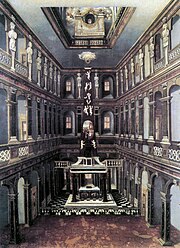Nun komm, der Heiden Heiland, BWV 61
| Nun komm, der Heiden Heiland | |
|---|---|
| BWV 61 | |
| Church cantata by J. S. Bach | |

|
|
| Occasion | First Sunday in Advent |
| Performed | 2 December 1714: Weimar |
| Movements | 6 |
| Cantata text | Erdmann Neumeister |
| Bible text | |
| Chorale | |
| Vocal |
|
| Instrumental |
|
Nun komm, der Heiden Heiland (Now come, Savior of the heathens),BWV 61, is a church cantata by Johann Sebastian Bach. He composed it in Weimar for the first Sunday in Advent, the Sunday which begins the liturgical year, and first performed it on 2 December 1714.
The cantata text was provided by Erdmann Neumeister, who quoted the Book of Revelation and framed his work by two hymn stanzas, the beginning of Martin Luther's "Nun komm, der Heiden Heiland", the main hymn for Advent with a melody based on Medieval chant, and the end from Philipp Nicolai's "Wie schön leuchtet der Morgenstern". The librettist quoted developed his thoughts like a sermon. Bach structured the cantata in six movements, beginning with a chorale fantasia, followed by a series of alternating recitatives and arias, and concluded by a four-part chorale. He scored it for three vocal soloists (soprano, tenor and bass), strings and continuo. Bach led the first performance on 2 December 1714. As Thomaskantor, director of music of the main churches of Leipzig, he performed the cantata again on 28 November 1723.
On 2 March 1714 Bach was appointed concertmaster of the Weimar court capelle of the co-reigning dukes Wilhelm Ernst and Ernst August of Saxe-Weimar. As concertmaster, he assumed the principal responsibility for composing new works, specifically cantatas for the Schlosskirche (palace church), on a monthly schedule.
...
Wikipedia
